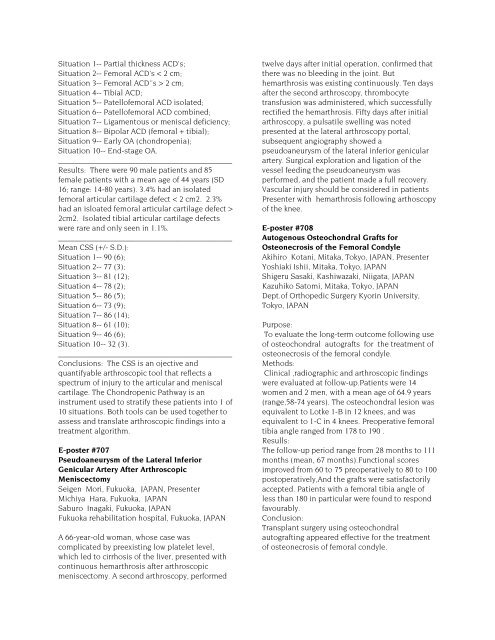POSTER ABSTRACTS - ISAKOS
POSTER ABSTRACTS - ISAKOS
POSTER ABSTRACTS - ISAKOS
You also want an ePaper? Increase the reach of your titles
YUMPU automatically turns print PDFs into web optimized ePapers that Google loves.
Situation 1-- Partial thickness ACD's;<br />
Situation 2-- Femoral ACD's < 2 cm;<br />
Situation 3-- Femoral ACD''s > 2 cm;<br />
Situation 4-- Tibial ACD;<br />
Situation 5-- Patellofemoral ACD isolated;<br />
Situation 6-- Patellofemoral ACD combined;<br />
Situation 7-- Ligamentous or meniscal deficiency;<br />
Situation 8-- Bipolar ACD (femoral + tibial);<br />
Situation 9-- Early OA (chondropenia);<br />
Situation 10-- End-stage OA.<br />
___________________________________________<br />
Results: There were 90 male patients and 85<br />
female patients with a mean age of 44 years (SD<br />
16; range: 14-80 years). 3.4% had an isolated<br />
femoral articular cartilage defect < 2 cm2. 2.3%<br />
had an isloated femoral articular cartilage defect ><br />
2cm2. Isolated tibial articular cartilage defects<br />
were rare and only seen in 1.1%.<br />
___________________________________________<br />
Mean CSS (+/- S.D.):<br />
Situation 1-- 90 (6);<br />
Situation 2-- 77 (3);<br />
Situation 3-- 81 (12);<br />
Situation 4-- 78 (2);<br />
Situation 5-- 86 (5);<br />
Situation 6-- 73 (9);<br />
Situation 7-- 86 (14);<br />
Situation 8-- 61 (10);<br />
Situation 9-- 46 (6);<br />
Situation 10-- 32 (3).<br />
___________________________________________<br />
Conclusions: The CSS is an ojective and<br />
quantifyable arthroscopic tool that reflects a<br />
spectrum of injury to the articular and meniscal<br />
cartilage. The Chondropenic Pathway is an<br />
instrument used to stratify these patients into 1 of<br />
10 situations. Both tools can be used together to<br />
assess and translate arthroscopic findings into a<br />
treatment algorithm.<br />
E-poster #707<br />
Pseudoaneurysm of the Lateral Inferior<br />
Genicular Artery After Arthroscopic<br />
Meniscectomy<br />
Seigen Mori, Fukuoka, JAPAN, Presenter<br />
Michiya Hara, Fukuoka, JAPAN<br />
Saburo Inagaki, Fukuoka, JAPAN<br />
Fukuoka rehabilitation hospital, Fukuoka, JAPAN<br />
A 66-year-old woman, whose case was<br />
complicated by preexisting low platelet level,<br />
which led to cirrhosis of the liver, presented with<br />
continuous hemarthrosis after arthroscopic<br />
meniscectomy. A second arthroscopy, performed<br />
twelve days after initial operation, confirmed that<br />
there was no bleeding in the joint. But<br />
hemarthrosis was existing continuously. Ten days<br />
after the second arthroscopy, thrombocyte<br />
transfusion was administered, which successfully<br />
rectified the hemarthrosis. Fifty days after initial<br />
arthroscopy, a pulsatile swelling was noted<br />
presented at the lateral arthroscopy portal,<br />
subsequent angiography showed a<br />
pseudoaneurysm of the lateral inferior genicular<br />
artery. Surgical exploration and ligation of the<br />
vessel feeding the pseudoaneurysm was<br />
performed, and the patient made a full recovery.<br />
Vascular injury should be considered in patients<br />
Presenter with hemarthrosis following arthoscopy<br />
of the knee.<br />
E-poster #708<br />
Autogenous Osteochondral Grafts for<br />
Osteonecrosis of the Femoral Condyle<br />
Akihiro Kotani, Mitaka, Tokyo, JAPAN, Presenter<br />
Yoshiaki Ishii, Mitaka, Tokyo, JAPAN<br />
Shigeru Sasaki, Kashiwazaki, Niigata, JAPAN<br />
Kazuhiko Satomi, Mitaka, Tokyo, JAPAN<br />
Dept.of Orthopedic Surgery Kyorin University,<br />
Tokyo, JAPAN<br />
Purpose:<br />
To evaluate the long-term outcome following use<br />
of osteochondral autografts for the treatment of<br />
osteonecrosis of the femoral condyle.<br />
Methods:<br />
Clinical ,radiographic and arthroscopic findings<br />
were evaluated at follow-up.Patients were 14<br />
women and 2 men, with a mean age of 64.9 years<br />
(range,58-74 years). The osteochondral lesion was<br />
equivalent to Lotke 1-B in 12 knees, and was<br />
equivalent to 1-C in 4 knees. Preoperative femoral<br />
tibia angle ranged from 178 to 190 .<br />
Resulls:<br />
The follow-up period range from 28 months to 111<br />
months (mean, 67 months).Functional scores<br />
improved from 60 to 75 preoperatively to 80 to 100<br />
postoperatively,And the grafts were satisfactorily<br />
accepted. Patients with a femoral tibia angle of<br />
less than 180 in particular were found to respond<br />
favourably.<br />
Conclusion:<br />
Transplant surgery using osteochondral<br />
autografting appeared effective for the treatment<br />
of osteonecrosis of femoral condyle.
















